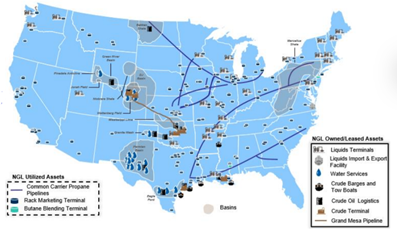Extracting The Most Value Out Of Your ETRM System

Businesses strive toward continuous improvement. When a business first starts, it’s inherently reactive and focused on the basic transactions. As processes and systems develop, so does the business evolve into more stability. The business becomes less reactionary and more focused on managing the immediate operations. At this point, companies look to replace disparate homegrown systems. Within the downstream and midstream energy sectors, they turn toward an energy trading risk management (ETRM) system.
CLICK HERE to learn how we can help your organization stay ahead of the curve by shifting to the ETRM of the future.
An ETRM unlocks the power of the business by providing discipline and a structure around business processes. For example, ION’s RightAngle supports a front-to-back workflow for liquid and bulk commodities operating across the downstream and midstream energy value chain. It allows the front-, middle-, and back-office to perform separate functions focused on managing the complexity of a trading organization. RightAngle allows for straight-through processing to speed up the order-to-cash process. It’s a conduit for interfaces from pricing feeds, bills of lading (BOLs), invoices, orders, and deals. It serves as a single repository for the proverbial “one version of the truth” before accounting transactions are created and sent to an enterprise resource planning (ERP) platform.
CLICK HERE to find out how we assist clients in upgrading to the latest versions of ION RightAngle.
However, to achieve the pinnacle of maturity and further improve, a company needs to embrace planning and look toward altering its processes once again. It needs to set up a feedback loop focused on testing future scenarios and create an optimal plan by which to achieve different objectives: minimize inventory, minimize total costs, maximize profit, etc. ION’s WAM tool allows companies to perform scenario analysis, create demand forecasts, or create an optimized plan to maximize profit or minimize costs.
This article examines the main components of ION’s WAM tool and breaks down the steps you can take to progress up the maturity model to achieve your highest potential.
Configure The Base Value Chain
An optimization tool like WAM provides the business with the quantitative power of statistical models that achieves specific objectives. The tools are tuned to solve for an objective function: maximize profit, minimize costs, minimize inventory, and minimize transport time. Each component of the value chain is configured to create a digital twin.
READ MORE: Lulled Into Complacency: How (Over) Managing Working Capital Harms Supply Chain Resiliency
The first step for the business is to map the physical reality of the asset network. This includes all supply points, production centers, terminals, and storage locations. The physical reality is configured so that the model can make decisions consistent with the real-world reality: capacity, minimums, maximums, operating hours, costs, etc. The virtual world is set up within the digital twin. The important factors to consider for modeling are those which drive the real-world decisions around the usage of the assets. It’s these factors that’ll inevitably be a part of the overall algorithm.
Incorporate The Reality & Complexity Of Transportation
Assets are linked together through the configuration of the logistical network to create routes. This is where the nuances of each mode of transportation and specific routes are set up in the model, which can include distances, transit time, batch sizes, capacity, fleet size, berth restrictions, time allowances for travel, and any other physical restriction that would drive real-world variability in the supply chain. The logistics network provides the critical link between suppliers, production and storage, and the eventual end customers. It will weigh heavily into the optimization to achieve objectives. The representative example below shows a typical asset map of pipelines and terminals that need to be connected digitally.

Model Inventory & Its Variability
A critical component of the assets is the incorporation of the inventory— how physical inventory is received into an asset, flows between assets, and how it’s drawn down and sold. The ebb and flow dynamics are constrained by real-world factors where decisions are made daily: operating targets, hard minimum and maximum boundaries, and any other physical limitations. Considerations for the usage of book vs. physical are also considered so that the model can have the best representation of position possible.

Layer In Contracts & Costs
After the physical reality is modeled, the contractual portfolio is layered on top. The contractual world is split between those contracts with suppliers, those with customers, inventory deals, and logistical contracts. With each of the contracts comes diligence to configure locations, specific counterparties, inventory obligations, timing, costs, and pricing.
Provide Linkages To ETRM System
Once the core of the model is established, linkages with the ETRM system must be established. The ETRM system will provide two main pieces of data. First, as the physical world of assets or contracts changes, those changes will be passed along to the sales and operations planning (S&OP) tool in a continuous feedback loop. The ETRM system will remain the system of record and “one version of the truth.”
READ MORE: Strategic Cost Management: Uncovering Supply Chain Deficiencies
Second, the ETRM system provides a ledger of the transactions that take place across the entire network. This too is critical in feeding back the details of orders and movements to the algorithm. Only in this way can the algorithm be dynamic and adjust plans and forecasts to continue meeting objectives.
Additional linkages can be provided to augment the ETRM and provide additional external factors that drive variability in the supply chain. For example, the weather is one of those main factors. Temperature changes and weather events inevitably drive human behavior. They have an impact to adjust projections for demand upward or downward. This data is then fed into the model for an additional level of realism.
Set Up The Demand Forecast
With the digital twin captured and a feedback loop established with the ETRM system, the next step should be to focus on the demand forecast.
Demand forecasting is powerful when done well. S&OP tools like WAM will focus on a combination of methodologies and models to produce the best-fit curves for predictions. Each statistical model and methodology have its own set of biases and limitations.
Strong tools like WAM will rely on a base demand of historical data to create an initial trend. This demand data will be de-weatherized and normalized so that the extremes are reverted to the mean. A tournament of models is then run with the tool ultimately selecting the best fit out of several possible scenarios. Then, finally, the near-term demand is weatherized to provide the inherent incremental increase or decrease in the demand. The result is presented to the user for analysis and final tweaks to add additional knowledge to the model.

Tune The Model
Any good model is only as strong as the assumptions it mirrors in the real world. Therefore, set constraints to reflect the realities of the situation. For example, while the overall capacity of a terminal may not change throughout the year (or its operating capacity), the inventory targets will change based on business strategy.
READ MORE: Revenue Enhancement: Gain Insight Into Your Supply Chain To Make Money
The same can be said for contracts and ensuring that their contractual performance is reflective of the set agreements with counterparties. If a contract doesn’t need to be fully utilized, then its percentage can be backed off, thereby allowing the model to draw upon it only as needed. Where there are certainties for agreements of deliveries, configure them as set lifting schedules.
Constraining Demand With Limited Supply
When the model is run, it should be done in a way to achieve an objective: maximize profit, minimize cost, etc. In doing so, the model will look for the best mathematical way in which to achieve each of the constraints (some as hard targets and others as softer ones). The net result will be the creation of orders across different timeframes. The orders represent the plan of movements needed to fulfill demand in the best optimal way, taking into consideration the physical realities of the supply chain.

Harness The True Power Of Feedback
The power of the plan is how it’s communicated seamlessly through the ETRM system and out to the real world. The ETRM system is configured to deliver orders to each of the counterparties so that the company may communicate its intentions to move products to fulfill customer needs and meet its goals. Therefore, the best S&OP tools are integrated so that the orders are created automatically within the ETRM system. Doing so leverages the full digital transformation and allows the organization to focus efforts on tuning the model daily.
Related Insights
Our experts are here
for you.
When you choose Opportune, you gain access to seasoned professionals who not only listen to your needs, but who will work hand in hand with you to achieve established goals. With a sense of urgency and a can-do mindset, we focus on taking the steps necessary to create a higher impact and achieve maximum results for your organization.
LeadershipGeneral Contact Form
Looking for expertise in the energy industry? We’ve got you covered.
Find out why the new landmark legislation should provide a much-needed boost for the development of carbon capture.




